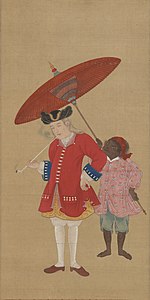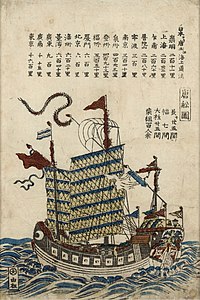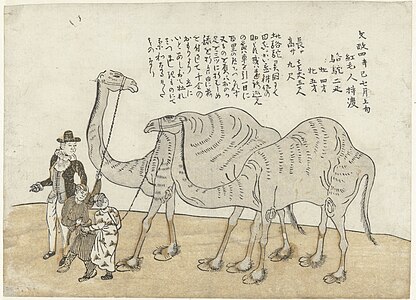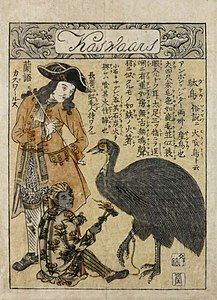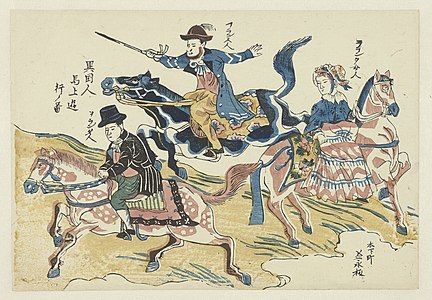
Nagasaki-e (Japanese: 長崎絵) is a genre of ukiyo-e woodblock prints, produced in Nagasaki during the Edo period, that depict the port city of Nagasaki, the Dutch and Chinese who frequented it, and other foreign curiosities such as exotic fauna and Dutch and Chinese ships. They were mostly produced for merchants who traveled to Japan on business.[1] Japanese people also bought such prints as they were curious about foreigners, with whom they couldn't meet themselves. Nagasaki-e print were also sold in Edo, Osaka, and provinces. Nagasaki was the only port that foreigners were allowed to visit in Tokugawa time, between 1641 and 1859.[1][2]
Technically, Nagasaki-e print were made on paper of inferior quality, with "earlier examples were made with gasenshi, a Chinese-style paper containing tan tree fibers (Pteroceltis tatarinowii maxim), rice-straw, and bleached bamboo. Sometimes, printers rubbed the colorants into the papers with horizontal or vertical strokes rather than the traditional circular motions used in nishiki-e."[1] The first nagasaki-e prints were made in the late 1720s. "The range of subject matter was wide, including foreign couples, children, families, pets, exotic birds and animals, female beauties, courtesans, landscapes, cityscapes, ships, maps, and military events."[1] Style was similar to that of Chinese nenga (年画).[1][2]
Production of these souvenir prints "grew out of an earlier map-making industry".[2] Several publishing houses produced the prints, among them Hariya (針屋), Toshimaya (豊島屋), Yamatoya (大和屋), and Bunkindō (文錦堂).[1][2] For most publishers nagasaki-e wasn't their main business.[1] One of the first examples of nagasaki-e prints were panoramic maps of the city, that were very popular and were printed for many years without any change.[1]
Most prints are anonymous, probably because the majority of authors were amateurs "who worked in foreign-trade positions in Nagasaki". One of the best-known authors is Kawahara Keiga, who had access to many Dutch paintings with the help of Franz von Siebold, who worked for the Dutch government at the Nagasaki port.[1]




